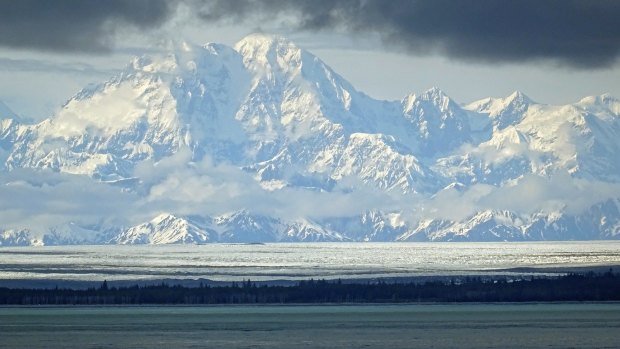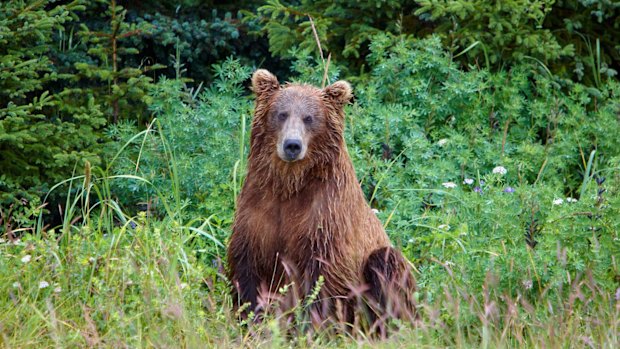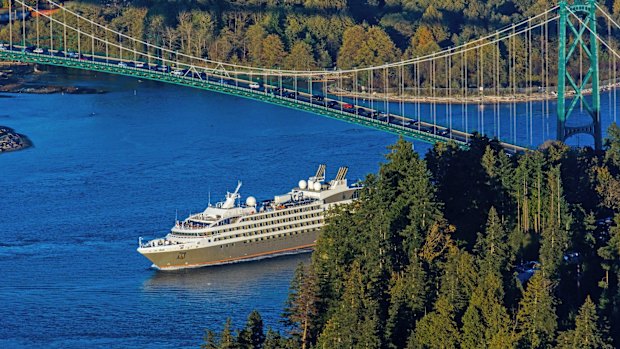This was published 7 years ago
Expedition to Alaska: Five star treatment on the cruise of a lifetime
By Brian Johnston

The St Elias Range east of Seward viewed from Icy Bay.Credit: Brian Johnston
One-upmanship is a shameless part of travel, and I have to say I'm feeling rather smug at four o'clock in the afternoon in the port of Seward. My compact ship Le Soleal is graced with a pale-grey hull and elegant white trim, and looks like a sleek shark in comparison to the great whale of a megaship at the adjacent dock. As wave after wave of passengers heaves onto the larger ship, a select few board Le Soleal for a different kind of cruise: nimbler, more adventurous, set to slide into remote bays and fiords that mainstream ships can't access.
Already I have a good idea of Alaska's physical power, since the port at Seward sits under a range of snowy mountains. As we set sail over dinner, the northern sun is still high in the sky and the scenery gets ever more dramatic as we cruise down a narrowing valley between cliffs where kittiwakes screech. As we exit into the open sea I stand on the aft deck and look back at one of the most spectacular coastal panoramas I've enjoyed at sea.
Perhaps I get excited too soon, because Alaska just gets ever grander as we sail south. Next day in College Fjord we're surrounded by eight glaciers and gushing waterfalls. Seals sit on ice floes, ignoring our sedate passage. By afternoon we're sailing into Barry Arm. Wrapped in blankets, I brave lunch on the deck and am rewarded over my quiche lorraine and salad as the captain slowly rotates the ship, commanding us to admire the scenery.

A bear sighting. Credit: Chris McLennan
After lunch, a Zodiac boat takes us close to creaking walls of glacial ice. It's 10C and raining, but the misty chill only adds to the feeling that we're deep in wilderness of untamed beauty and raw power. This is what excursion cruising is all about: not watching distant coastlines pass from a big ship, but getting up close to scarcely visited places. Two otters lift their heads out of the water. We sail into a cave entrance, lovely with gold-green minerals and algae. Floating ice is jagged as shattered crystal, and the glaciers are fissured wonders of glowing blue.
Next morning we're crossing the Gulf of Alaska, one of the rare times on this 13-day expedition that we're out of sight of land. I attend a lecture on Alaskan geography by Yves Petit, a Canadian 20-year expert in the region. He and other naturalists are on deck that afternoon for our three-hour navigation into Icy Bay, which is backed by America's second-highest mountain. Malaspina Glacier here is one of the largest on the continent, though we're only seeing its very end. Icy Bay was created by numerous recently retreating glaciers, and ice chunks cover the water like scattered confetti. Mt Elias provides a dance of the seven veils as cloud shifts across its face, revealing snowy splendour.
This is the rhythm of our days. Lazy lunches and a glass of wine are followed by a patisserie and strong coffee, then a Zodiac excursion to admire sea lions and alpine panoramas. The luxurious domesticity of the ship is a dizzying contrast to Alaska's vast wilderness. There are occasional ports of call too, such as Haines, with its population of 2500 people, 1800 dogs and two horses. The town sits on a hillside gazing at a mountain range across a tight fiord where the tides rise and fall six metres. I take a shore excursion onto the Chilkat River, home to 5000-odd bald eagles. "Sometimes you see 50 in a tree, it's like a Christmas tree decorated with balls, except the balls are eagles," says our guide Renee, who is a mine of marvellous information on everything Alaskan, from arthritis in moose to eagles' feathers.

Ponant ship Le Soleal in Vancouver harbour.Credit: Ponant
On day seven, Le Soleal is deep in Endicott Arm, a fiord 70 kilometres south of Juneau whose floating ice signals Dawes Glacier ahead. Another Zodiac excursion is scheduled, and no one has had enough of them yet: we scramble into the boats with indecent jostling. My accompanying naturalist this time is Alain, who has an agreeably French way of looking at things. "That iceberg could be in the Louvre," he says as an abstract sculpture floats past. "Don't you love those shapes? That floating ice is ephemeral, you'll never see that again."
Up close, the glacier is a skyscraper of frozen blue. Alain nudges the Zodiac into the cliff face and we turn our faces up in wonder at a waterfall. It surprises me how varied these Zodiac excursions are. Today a glacial valley, next day we're right among a sea lion colony in The Brothers islands, so close we can see their whiskers twitching. The day after, we're in Red Bluff Bay and finally spot the elusive bears we've been longing for, prowling along the shoreline.
A day in Sitka stretches our sea legs. The Russians settled Sitka in 1799 as New Archangel, and in 1867 sold Alaska to the United States for two cents an acre. Sitka remained the capital of Alaska Territory until 1906. Unusually, the town faces the open sea and has a wider setting than most Alaskan ports, on a bay of pine-topped islands and a rearing volcano. The town has eschewed the big cruise facilities of Juneau and Ketchikan and is a pleasant glimpse into everyday Alaska, to which is added a fair dose of history. It has a Russian cathedral and bishop's house, old fortifications and a graveyard of leaning metal crosses.
That evening the sea is purple, the mountains blue and rimmed with orange. Whale spouts blow as the sun sinks, sending passengers scrambling from their desserts to ship's railings. Over the next few days we slide south through the Inside Passage, crossing into Canada at Prince Rupert, with its dull waterfront souvenir shops and glorious McClymont Park Trail through a damp forest of mossy pines and ferns. We have a lecture on the native people of British Columbia, a game of trivia, another whale alert. Alaska's over-the-top landscapes are behind us, but the passing scenery is still gorgeous. Le Soleal sails between forest-covered hills under a blue sky. From my glassed-in cabin shower I can look right out and not miss a minute of it. I fancy I can hear whales singing beneath the ship, but maybe it's just me, humming to myself in delight.
CRUISE CUISINE
An expedition cruise in the Alaskan wilderness doesn't mean foregoing life's finer pleasures. Ponant is a French cruise company that strives to maintain Gallic flair, especially in the main dining venue of Le Soleal (and similarly on its near-identical sister ships L'Austral and Le Boreal). Evening meals in the lower-deck main restaurant feature upmarket a la carte dining that occasionally runs to adventurous dishes – at least for cruise ships – such as escargot ravioli, superlative foie gras and frog's leg terrine. However, little will alarm the mainstream diner, and the chef sensibly creates upmarket but relatively unfussy dishes, though many are rich in French sauces. Courses avoid American excess for more modest European portions. The menu also has light and vegetarian offerings, as well as regulars such as chicken or grilled Alaskan salmon.
The complimentary wine that comes with meals is nearly always satisfying. Cheese selections are good and in regular supply, though it's a pity that the cheeses are never identified. As you'd expect of a French ship, invariably crusty and fresh croissants and breads are excellent, and post-meal pastries such as raspberry-and-almond tart outstanding. There are good ice creams, occasionally with interesting flavours such as orange or coconut. However, the French have never understood afternoon tea; expect only a few uninspiring, self-serve nibbles in the lounge.
The more casual Deck 6 restaurant provides buffet-style meals and a simpler, less French selection that tends more towards comfort food. The serving area is a little cramped and the food selection modest, yet perhaps the best I've tasted from any cruise-ship buffet. Passengers can choose from a couple of soups, an assortment of salads and cold cuts, and a small number of hot dishes. This restaurant has a very pleasant outdoor dining area that provides fabulous passing views.
Service is patchy. Waiters such as Manuel and Joseph in the informal restaurant are excellent, others fall well short in their attentiveness. The main restaurant seems to have little managerial oversight, with confused service and Asian waiters who (understandably) struggle with orders, especially when delivered in French. There's no additional charge for room service, which has the usual staples such as burgers and steaks. Just remember this is a French ship: ask for your steak well done if you don't want it leaping off the plate.
The writer travelled as a guest of Ponant.
TRIP NOTES
MORE INFORMATION
GETTING THERE
Air Canada flies from Sydney and Brisbane (15.5 hours) to Vancouver with onward connections to Anchorage (3.5 hours). Phone 1300 655 767, see aircanada.com
CRUISING THERE
Like all expedition companies, Ponant varies its cruises annually. Next year it has one Alaska-Canada itinerary, a 14-night Nome to Vancouver voyage on Le Boreal departing on September 13, 2017, that visits the far north coast and Inside Passage. It differs from the cruise described here, but similarly visits Sitka, The Brothers and Prince Rupert. Prices from $10,964pp twin share with a 15 per cent advance-purchase discount, which reduces as cabins sell. Expect new itineraries in 2018. Phone 1300 737 178, see ponant.com
Sign up for the Traveller Deals newsletter
Get exclusive travel deals delivered straight to your inbox. Sign up now.